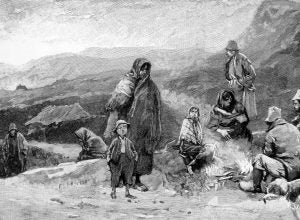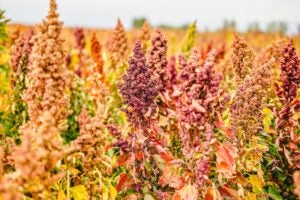Grow enough food to feed a family of four for a year on 1/20th of an acre?
That’s the claim made in a recent article I came across. That’s only 2,178 square feet, the size of a three-bedroom house. I certainly don’t want to discourage anyone from having a garden, but it sounded unrealistic to me. So I started gathering nutrition facts to check it out.
Turns out it would be impossible.
It takes about 2.9 million Calories to feed a family of four for a year at a rate of 8,000 Calories per day. (Note: I used the big “C” for Calorie because that designates kilocalories, which is the way calories (small “c”) are represented in foods. A calorie is defined as the energy required to raise the temperature of one gram of water one degree Centigrade. Big “C” is 1,000 small “c” calories.).
If you planted the 1/20th of an acre to potatoes — the most intense way to grow Calories per acre — and it yielded like a commercial field (60,000 pounds/acre, or 24 million Calories) you would have 3,000 pounds and 1.2 million Calories, about 1.7 million short of a year’s supply.
And, of course it would be boring to eat only potatoes … but it would be nourishing. Potatoes are considered a complete food in that protein content is high and has all the essential amino acids (essential means those a body cannot make). Potatoes also have the fats and carbohydrates a body needs, plus a full complement of vitamins and minerals, except for vitamin B12. No plants produce adequate B12. A person must eat meat or dairy or take a pill to get their B12.
The Irish relied almost completely on potatoes for food in the early 1800s. Then in the middle of the 1840s a blight struck, turning fields black in days, and infecting the tubers and shriveling them up. The result was a terrible famine. By 1850 a million people had starved to death, and 2 million had emigrated to other countries. The culprit, a fungus called P. infestans, still infects fields today, but is controlled with resistant varieties and fungicides.

A person can no doubt grow all of the vegetables they need in season on 1/20th of an acre, and have some left over to can or freeze. When I was a young boy in the 1940s, my family had a big garden, about one acre in size. We grew radishes, peas, green beans, carrots, parsnips, beets, potatoes, turnips, tomatoes, sweet corn, cabbage, lettuce, peppers, onions, squashes, melons, and strawberries. In our small orchard were apples, prunes, apricots, blackberries, raspberries, and currents for jelly. Dad rotated dry beans with wheat, so we always had enough beans around. Everyone hoed weeds, but Mom spent her summer picking and canning.
In the fall we dug potatoes and put them in the cellar. The rest of the root crops were left in the ground with dirt heaped up over the row to keep them from freezing. We dug them as needed all winter. Cabbage was pulled and turned upside down next to the woodshed out of the winter winds. Soon they were covered with snow, and stayed fresh until spring. Squash were stored in the house at the head of the stairs, where temperatures stayed around 40 to 50 degrees through the winter. We ate well all year.
If a person divided his or her 1/20th acre garden into 10 parts (.005 acre each) and planted something different in each one, the Calorie yield in millions might look like this: Potatoes, 0.12; lettuce, 0.014; cabbage, 0.05; tomatoes, 0.016; beets, 0.02; carrots, 0.022; sweet corn, 0.002; green beans, 0.006; dry beans, .023, quinoa, .009. That adds up to 0.282 million, well short of the 2.9 million needed to feed a family of four for a year.

I added quinoa to illustrate a couple of points. Quinoa is as high as any grain in Calories per pound (1,700), but yield is so low (1,000lbs/A vs. 6,000 lbs+ for wheat) that calories per acre are eight to nine times less. This is a problem for the pundits who want to replace wheat with more exotic grains: How do you feed an expanding population? It is unlikely that quinoa yields will ever approach those of wheat, corn, or rice, even if genetic engineering is used. We have not seen the limits of wheat, corn and rice yields yet either.
The other reason I included quinoa is that its nutrient profile is the best of any grain. Like potatoes, it has a complete profile of amino acids, vitamins and minerals, and well balanced in protein, fats, and carbohydrates. For someone who wants to grow a garden grain, it is a good choice, not only because of its balanced nutrients but also because it is expensive to buy in the grocery store.
Jack DeWitt is a farmer-agronomist with farming experience that spans the decades since the end of horse farming to the age of GPS and precision farming. He recounts all and predicts how we can have a future world with abundant food in his book “World Food Unlimited.” A version of this article was republished from Agri-Times Northwest with permission.



